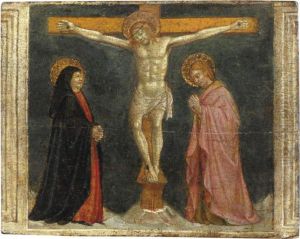Tommaso Di Giovanni Di Simone Guidi Paintings
Tommaso di Giovanni di Simone Guidi, better known as Masaccio, was a pivotal figure in the early Renaissance painting, marking a clear departure from the Gothic style to a more naturalistic and humanistic approach. Born in 1401 in Castel San Giovanni di Altura (now San Giovanni Valdarno, near Florence), Masaccio was part of a new generation of artists that sought to explore perspective, light, and the human form in unprecedented ways. His brief career, ending with his untimely death in 1428, was nonetheless transformative for the course of Western art.
Masaccio's early life is somewhat obscure, but it is known that he was apprenticed to a painter, possibly Bicci di Lorenzo, in Florence. By 1422, he was registered in the Florentine Guild of Saint Luke, the guild for artists, which suggests he had achieved a degree of professional recognition by this time. Masaccio's works are characterized by their use of perspective, a technique he explored and applied with revolutionary effect, drawing influence from his contemporaries, such as Brunelleschi and Donatello, who were also pushing the boundaries of art and architecture.
Perhaps Masaccio's most famous work is the Brancacci Chapel frescoes, in the church of Santa Maria del Carmine in Florence. These frescoes, which depict scenes from the life of St. Peter, showcase Masaccio's mastery of perspective and his ability to create lifelike figures imbued with emotion. His figures have a sense of weight and three-dimensionality that was unprecedented at the time. The Tribute Money, one of the scenes from this cycle, is particularly noted for its use of atmospheric perspective and chiaroscuro, techniques that would greatly influence future generations of artists, including Michelangelo and Leonardo da Vinci.
Masaccio's impact on Renaissance art cannot be overstated. Despite his career being cut short by his death at the age of 27, his approach to painting laid the groundwork for the developments in art that would unfold over the next centuries. His focus on realism, along with his studies of light and shadow, set a new standard for painting. Masaccio is often hailed as the 'Father of the Renaissance,' his contributions marking a turning point from the stylized forms of the medieval period to a more naturalistic representation that would dominate European art for the next 400 years.
